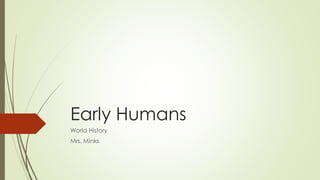
Early humans
- 1. Early Humans World History Mrs. Minks
- 2. Warm-up: On an index card write your answer to the following: Describe how you think early humans might have spent their days.
- 3. Before History Prehistory means the period before writing was developed Story of early humans relies on archaeological and biological information
- 4. Archaeology and Anthropology Archaeology is the study of past societies through an analysis of what people left behind (e.g. fossils, weapons, tools, pottery, etc.) These things that the archaeologists study are called artifacts. Anthropology is the study of human life and culture. Anthropologists also use artifacts to determine how people lived their lives.
- 5. Dating artifacts and fossils Radiocarbon dating – accurate for dating objects that are no more than about 50,000 years old
- 6. Dating artifacts and fossils Thermoluminescense dating – enable scientists to make relatively accurate measurements back to 200,000 years
- 7. DNA gives insight into ancient civilizations DNA is providing new information on human evolution which gives us even more insight into the lives of early peoples.
- 8. Early stages of development: From hominids to homo sapiens Earliest humanlike creatures lived in Africa three to four million years ago and were called australopithecines. Australopithecines were the first hominids (humans and other creatures that walk upright) to make simple stone tools. Second stage in human development: Homo erectus which used larger and more varied tools (about 1.5 million years ago). Third stage in human development: Homo sapiens (250,000 years ago). There were two subgroups of Homo sapiens: Neanderthals Homo sapiens sapiens
- 9. Neanderthals First found in the Neander Valley in Germany, more found in Europe & Southeast Asia Remains dated between 100,000 and 30,000 BCE Relied on stone tools First early people to bury dead Made clothes from skins of animals that they killed for food
- 10. Homo sapiens sapiens First anatomically modern humans (CET65R8Vople who looked like us) Appeared in Africa between 150,000 and 200,000 years ago, spread out around 100,000 years ago By 30,000 BCE Homo sapiens sapiens had replaced Neanderthals who had largely died out, possible due to conflict between the two groups By 10,000 BCE Homo sapiens sapiens could be found throughout the world All humans today belong to the same subgroups of human beings.
- 11. The Stone Ages Paleolithic Era(Old Stone Age) Mesolithic Era(Middle Stone Age) Neolithic Era (New Stone Age)
- 12. Paleolithic Era: people lived as nomads, in small hunting and food gathering groups. Nomadic Simple tools and weapons out of stone, bone, or wood Caves and rocky overhangs for shelter Cave paintings Learned to build fire for warmth, cooking, and signals Tools used for hunting, protection, fishing, and shelter Had spoken language Lived in groups of two to three dozen people Men did the hunting Women gathered fruit, berries, roots, grasses
- 13. The Neolithic Agricultural Revolution Neolithic Agricultural Revolution was the change from nomadic to farming life. This led to the development of civilization. People Before Relied on hunting and gathering Nomads lived in small hunting and food- gathering groups Waited for migrating animals to return each year People After Learned to farm and produce own food Settled into permanent villages Learned to domesticate (tame) wild animals, providing a dependable source of meat
- 14. The End of the Neolithic Age Between 4000 and 3000 BCE, the use of metals emerged Copper was first metal to be used in making tools After 4000 BCE copper and tin were combined, making bronze As people mastered art of farming complex societies developed By the beginning of Bronze Age large numbers of people were concentrated in Mesopotamia, Egypt, India, and China. Welcome to the Bronze Age
- 15. Exit Ticket: On the back of your index card answer this question: What important and dramatic developments took place during the Neolithic Age?
Hinweis der Redaktion
- These social scientists have developed scientific methods to carry out their work. Excavations around the world have uncovered fossil remains of early humans, ancient sites, burial grounds, and more. Examining and analyzing these remains give archaeologists a better understanding of ancient societies. By examining artifacts like pottery, tools, and weapons, scientists learn about the social and military structures of a society. Bones, skins, and plants seeds help them piece together the diet and activities of early people.
- How do scientists date their finds? Determining the age of human fossils makes it possible to understand when and where the first humans emerged. All living things absorb a small amount of radioactive carbon (C-14) from the atmosphere. After a living thing dies, it slowly loses C-14. Scientists can calculate age of an object by measuring the amount of C-14 left in it.
- Thermo dating measures the light given off by electrons trapped in the soil surrounding fossils and artifacts.
- Blood, hair, and plant tissue molecules left on rocks, tools, and weapons may survive millions of years. Analyzing these organic remains tells us more about humans, their use of tools, and the animals they killed.
- Homo erectus were first to leave Africa and move into Europe and Asia. They could do this because they learned how to use fire to keep warm in colder areas.
- Some scientists maintain that burial of dead indicates a belief in an afterlife.
- Spread of modern humans was a slow process. Groups of people moved beyond their old hunting grounds at a rate of only two to three per generation, probably in search of food. But this was enough to populate the world over tens of thousands of years.
- The use of metals marked a new level of human control over the environment and its resources. Bronze was harder and far more durable than copper. This led to the Bronze Age.